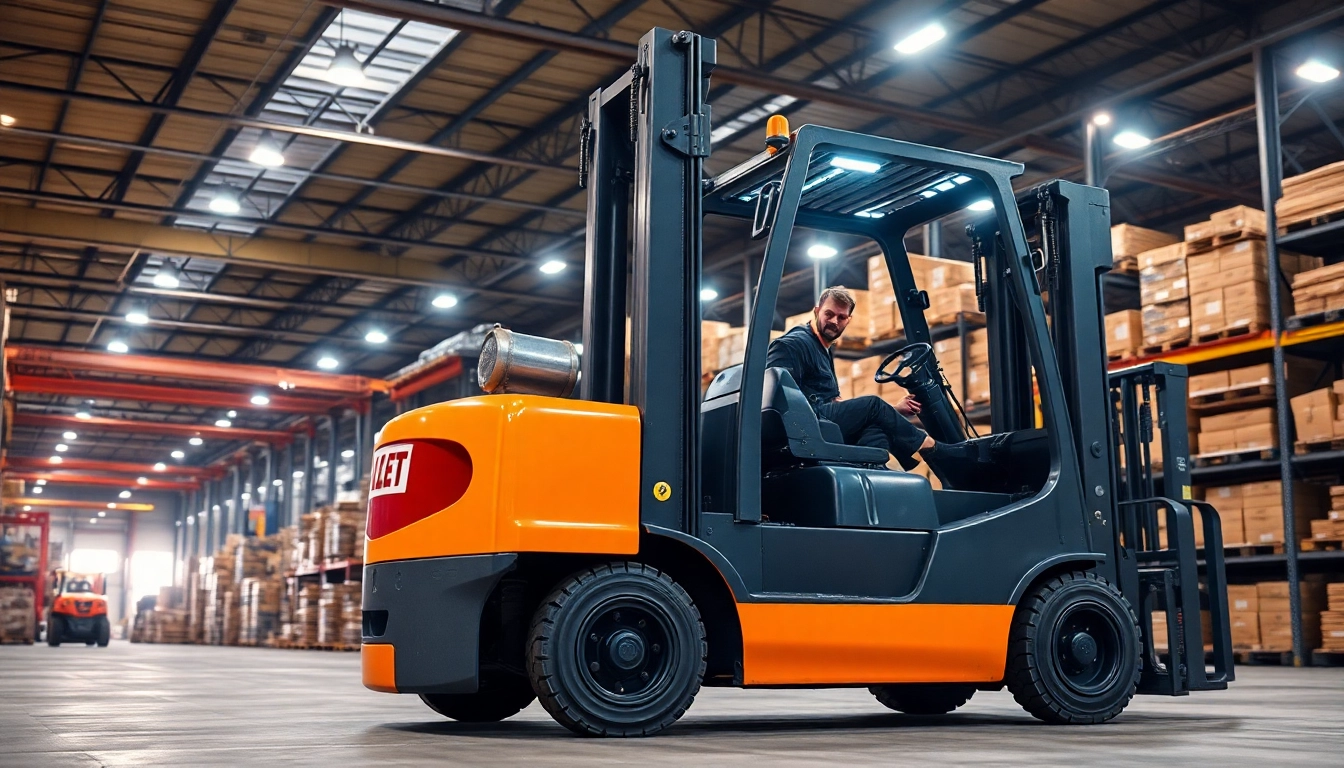Understanding Forklift Rental: Options and Benefits
In modern logistics, manufacturing, and construction industries, the efficiency of moving heavy loads directly impacts operational success and profitability. Forklifts, as essential material handling equipment, facilitate swift and safe transportation of goods within warehouses, factories, and distribution centers. While owning a fleet of forklifts might seem ideal for some organizations, the pandemic, fluctuating demand, and rising capital expenditures have driven many businesses towards flexible and cost-effective solutions—most notably, forklift rental.
This approach offers a versatile means to access high-quality machinery without the long-term commitment of ownership. Below, we delve into the core aspects of forklift rental—covering the types available, rental durations, advantages over purchasing, selection criteria, cost factors, and best practices to maximize your investment. Whether you’re contemplating short-term projects or establishing a long-term rental partnership, this comprehensive guide is designed to inform your decision-making process.
Types of Forklifts Available for Rent
The diverse range of forklifts available in the UK market caters to various operational needs. Selecting the right type hinges on understanding your load requirements, operational environment, and duration of use. The principal categories include:
- Counterbalance Forklifts: Recognizable and most frequently used, these forklifts feature weights at the rear to balance the load in front. Ideal for general warehouse applications, they come in electric, diesel, and LPG variants, suitable for indoor and outdoor use.
- Reach Trucks: Designed for narrow aisle warehousing, reach trucks extend their forks forward to access pallets stored deep within shelving units. These are perfect for maximizing vertical storage space in tight environments.
- Pallet Trucks (Manual or Electric): Used primarily for short-distance and pallet transportation tasks, pallet trucks are lightweight and maneuverable, suitable for lighter loads.
- Telehandlers: Combining forklift and crane features, telehandlers are versatile for lifting heavy loads at height, often employed in construction, agriculture, and large storage facilities.
- Order Pickers: Specifically designed for picking individual items at height in warehouses, these equipment enhance picker productivity and safety.
Each forklift type accommodates specific operational demands, and choosing the right machinery involves assessing load capacities, working environment, and contractual duration. Reputable rental providers often maintain fleets with modern, well-maintained machines, ensuring safety and reliability for your projects.
Short-term vs. Long-term Rental: Which Is Right for You?
Deciding between short-term and long-term forklift rental depends on your project scope, budget, and operational flexibility requirements. Here is an in-depth comparison:
Short-term Rental
Typically spanning from a few days to a few months, short-term rentals are ideal for temporary projects, seasonal peaks, or equipment testing. They offer significant flexibility, allowing businesses to scale up or down as needs evolve. Companies benefit from minimal commitment, immediate availability, and often, inclusive maintenance and support. For instance, event setups or construction projects with unpredictable timelines rely heavily on short-term leasing.
Long-term Rental
Usually exceeding six months and sometimes extending up to several years, long-term rentals are suitable for ongoing operational needs. They provide more predictable costs and often include asset management options, maintenance packages, and support services. Long-term leasing can resemble a hybrid of rental and leasing, enabling businesses to access newer machinery with flexible upgrade options without capital expenditure.
Each option has its advantages. Short-term rentals prioritize flexibility and minimal capital outlay, while long-term rentals favor stability and operational continuity. Smart businesses assess their project duration, cash flow, and strategic goals before choosing the right rental structure.
Key Advantages of Renting a Forklift Over Buying
Opting to rent over purchase offers numerous strategic and financial benefits, transforming how organizations manage their material handling needs. The core advantages include:
- Cost Efficiency: Rental eliminates large upfront capital investments, enabling companies to allocate funds more effectively. Periodic costs, such as rental fees, are predictable, enabling better budgeting.
- Flexibility and Scalability: Rental agreements can adapt to your operational needs, allowing you to upgrade or change machinery promptly as demands shift.
- Access to Modern Equipment: Rental providers maintain up-to-date fleets, ensuring you’re operating with the latest safety standards, technology, and efficiency features.
- Maintenance and Support: Most rental contracts include maintenance, servicing, and repairs, minimizing downtime and operational disruptions.
- Reduced Depreciation Risks: As the equipment remains the property of the rental company, your business is insulated from devaluation and resale concerns.
- Tax Benefits: Rental expenses are often fully deductible as operational costs, providing potential tax advantages.
- Risk Management: Economies of scale and maintenance support mean less exposure to unforeseen costs or equipment failures.
For example, a logistics firm scaling up for peak season might rent additional forklifts short-term, avoiding the costs and risks of purchasing equipment that may not be needed afterward. Conversely, manufacturing plants requiring consistent, long-term operation benefit from leasing agreements that include maintenance and flexibility.
How to Choose the Right Forklift Rental Provider
Selecting a supplier is a critical step towards ensuring operational efficiency, safety, and cost-effectiveness. To make an informed decision, consider these factors:
Assessing Industry Experience and Fleet Quality
Look for providers with extensive industry experience and a proven track record. A reputable rental company maintains a modern, diverse fleet of well-maintained forklifts, adhering to safety standards such as LOLER and LOLER-compliant maintenance protocols. Ask about fleet renewal policies, maintenance schedules, and their capacity to supply the specific forklift types you require.
Pricing, Delivery, and Support Services
Transparent pricing with no hidden charges is essential. Confirm what’s included—delivery, operator support, maintenance, and insurance. Delivery speed and coverage should match your project timelines, especially if you require equipment at short notice. Additionally, evaluate the support services, such as technical assistance, operator training, or emergency repairs.
Customer Reviews and Testimonials
Continual feedback from other clients offers insight into the provider’s reliability, customer service, and overall satisfaction. Reputable providers often showcase testimonials and case studies demonstrating their commitment to quality and client success.
For instance, a supplier with positive reviews for timely delivery in various regions within the UK, backed by professional support, can significantly reduce operational risks.
Factors Affecting Forklift Rental Costs in the UK
Rental prices vary depending on multiple factors that influence the total cost of ownership for a rental period. Understanding these elements helps in budgeting accurately and negotiating better deals.
Rental Duration and Load Capacity Impact
Longer rental terms often provide discounts, but per-day charges tend to decrease with longer commitments. Load capacity significantly influences price; higher capacity forklifts (e.g., 3+ tonnes) incur higher rental fees due to their enhanced engineering, safety features, and maintenance costs.
Types of Fuel and Equipment Features
Electric forklifts tend to be more economical in the long run with lower fuel and maintenance costs, especially suitable for indoor use. Diesel and LPG models may cost more but are preferred for outdoor, heavy-duty operations. Equipment features like advanced safety systems, telematics, or automation can also impact weekly or monthly rates.
Additional Services: Operator Hire and Insurance
Many rental agreements offer operator hire services, which can be economical for businesses lacking qualified staff. Insurance, whether included or purchased separately, varies widely and influences overall costs. Evaluating total packages—including training, insurance, and support—ensures clarity and maximizes ROI.
Implementing Forklift Rental: Tips and Best Practices
To optimize the benefits of forklift rental, it’s vital to adopt strategic planning, safety, and maintenance routines. Effective implementation minimizes downtime, reduces costs, and enhances safety.
Scheduling and Planning for Peak Efficiency
Proper scheduling aligns forklift use with workload peaks and project deadlines. Using project management tools or fleet tracking systems ensures efficient deployment and reduces idle time. Advance booking for high-demand periods guarantees equipment availability.
Training and Safety Compliance
Ensuring operators receive certified training not only complies with legal requirements but also minimizes accidents and equipment damage. Regular refresher courses and adherence to health and safety protocols cultivate a safety-oriented workplace environment.
Maintenance and Equipment Checks
Although many rental agreements include maintenance, daily pre-shift inspections—checking brakes, fluid levels, tires, and controls—are essential. Prompt reporting of issues ensures swift repairs, preventing costly breakdowns. Implementing a maintenance checklist enhances safety and prolongs equipment lifespan.
Measuring Success and Optimizing Your Forklift Rental Experience
Continuous evaluation ensures your rental investment yields maximum productivity and cost savings. Here are effective ways to measure and improve your forklift rental strategies:
Tracking Productivity Metrics
Establish key performance indicators (KPIs), such as loads moved per shift, turnaround times, and downtime durations. Utilizing telematics and fleet management software provides real-time insights, helping identify bottlenecks and inefficiencies.
Cost Savings and ROI Analysis
Regularly compare rental expenses against productivity gains and operational efficiencies. Tracking metrics over time reveals cost benefits, guiding future rental decisions and negotiations.
Building Long-term Rental Partnerships
Developing a strategic partnership with a reliable rental provider fosters preferential rates, prioritized support, and tailored services. Long-term relationships also facilitate upgrades, maintenance planning, and workforce training, ultimately enhancing operational resilience.









